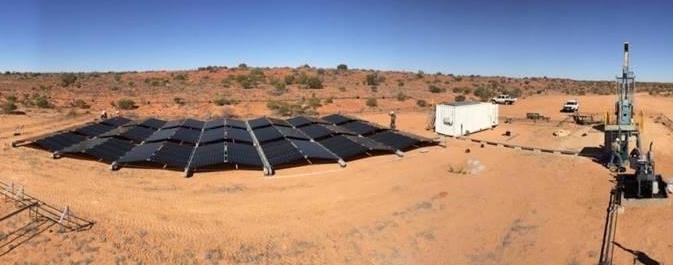

Australian oil and gas major Santos has unveiled plans to convert 56 of its remote crude oil beam pumps to 100 per cent solar and battery storage, in the surest and perhaps most ironic sign yet that renewable energy is the cheapest – and not just the cleanest – way forward for all walks of industry.
The $16 million solar and battery rollout – 3.2MW of PV in total and batteries at each of the 56 sites across the Cooper Basin in South Australia and Queensland – has won $4.2 million in funding from the Australian Renewable Energy Agency after a successful pilot installation (see image above).
Depending on the success of the roll-out, Santos plans to convert a a further 151 pumps across the Cooper Basin to solar and batteries, which – added to the initial 56 sites – would save 140 barrels of oil a day currently used to fuel the pumps.
Santos managing director and CEO Kevin Gallagher said the solar beam pump – born of the company’s own Energy Solutions team – was a “perfect demonstration” of the oil major’s strategy “to become Australia’s safest, lowest cost onshore operator in action.”
“The solar beam pump will reduce emissions and waste from oil production, saving 140 barrels of oil per day which is required to fuel the pumps, and instead will be sold for beneficial use,” he said.
“Our own consumption of fuel in the Cooper Basin is equivalent to about five per cent of east coast domestic gas demand, so if we can extend our use of renewables to our gas operations, we can also free up more natural gas for sale, which is a good way to put downward pressure on gas prices.
“Renewables will help reduce costs over time not only by cutting our fuel consumption, but also by eliminating the costs of transporting fuel by road over long distances to our wells.”
ARENA said on Tuesday that Santos’ efforts were also expected to result in increased confidence that renewable energy provides the reliability required for resources applications and see other companies follow suit.
But for many companies – big and small – the penny has already dropped.
Earlier this year, for instance, ASX listed renewables developer Carnegie Clean Energy won grant funding from the federal government’s National Energy Resources Australia (NERA) to integrate solar PV the Blacktip Wellhead Platform – an unmanned facility operated by Italian oil and gas company Eni in the Southern Bonaparte Basin.
And Australian oil and gas giant Woodside revealed almost exactly a year ago that it was installing an ABB-designed 1MWh battery storage micro-grid on its massive Goodwyn A platform in the north-west shelf – so that the operations could burn less gas and have less need for a back-up diesel generator.
Outside of the oil and gas sector there are many examples, too.
Alinta Energy recently revealed plans to build what would be Australia’s biggest off-grid solar farm to help power the Christmas Creek iron ore mine in the Pilbara, and other Fortescue mining operations.
And a nickel miner Independence Group is going partially solar at its Nova nickel operation in Western Australia, through a PV installation and power purchase agreement with remote power generation specialist Zenith Energy.
And ARENA itself has previously supported a solar farm at Weipa and a solar and battery project at the Degrussa Copper and Gold Mine, and has funded a range of other off-grid projects.
Nevertheless, Santos’ plans are some of the biggest yet in Australia, and for ARENA mark the Agency’s first off-grid project with the oil and gas industry, and first off-grid project that involves switching to 100 per cent renewables.
It is also the next step towards commercialising the Santos-made technology “by providing adequate scale needed to achieve supply chain and execution synergies,” and allowing suppliers to cut unit costs.
“Assisting the resources sector in turning to renewable alternatives is something we’re extremely proud of,” said ARENA CEO Darren Miller in comments on Tuesday.
“Santos will be ARENA’s first off-grid project with the oil and gas industry, building upon our previous support for implementing renewable energy at remote operations around Australia.
Australia’s energy minister Angus Taylor was also keen to weigh in on the big news, even if he couldn’t manage to do so without resorting to Coalition energy policy tropes.
“This project is supporting an industry that is reliant on 24/7 power to ensure continuous operation,” he said.
“It demonstrates the potential of renewable energy, backed up by sufficient storage, to provide affordable and reliable energy at remote and off-grid locations around Australia.”

Sophie is editor of One Step Off The Grid and deputy editor of its sister site, Renew Economy. Sophie has been writing about clean energy for more than a decade.


